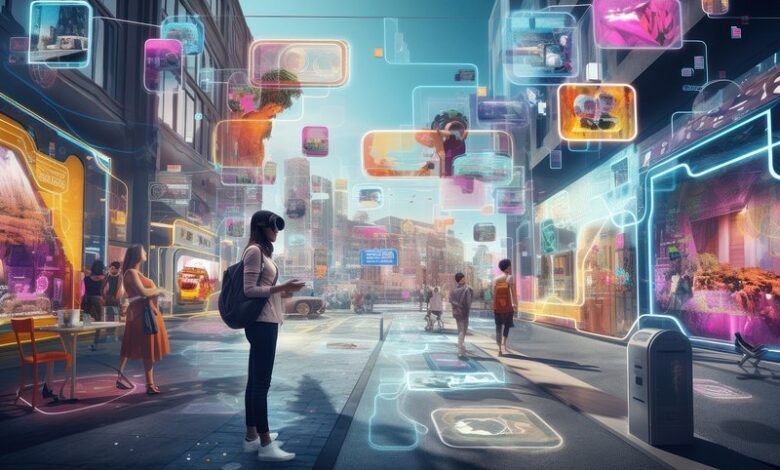Metaverse Tech Drives Retail Revolution

The retail industry stands at a critical juncture, moving rapidly away from traditional brick-and-mortar experiences and even beyond the constraints of two-dimensional e-commerce websites. The engine driving this next evolutionary leap is the Metaverse—a collective virtual shared space that combines augmented reality (AR), virtual reality (VR), and blockchain technology to create persistent, immersive, and interactive shopping environments. This transformation is not merely about selling virtual goods; it’s about using Metaverse Tech Drives Retail Revolution to fundamentally redefine customer engagement, brand loyalty, and the very nature of digital and physical transactions. For businesses dependent on high traffic and premium advertising (crucial for high-yield Google AdSense and SEO), mastering this frontier is essential for unlocking the next multi-trillion dollar consumer market.
The adoption of Metaverse technologies allows retailers to overcome the key limitations of current online shopping: the lack of sensory experience, the inability to accurately size and visualize products, and the absence of social interaction. By creating virtual showrooms, enabling digital try-ons, and integrating verifiable digital ownership through Non-Fungible Tokens (NFTs), retailers can create seamless, engaging shopping journeys that bridge the digital and physical worlds. This comprehensive analysis will explore the core technological pillars supporting this revolution, detail the new high-value business models emerging, outline the strategic advantages for customer retention, and address the governance and security challenges inherent in this lucrative, borderless retail frontier.
A. Core Technologies Reshaping the Retail Experience
The immersive retail experience delivered by the Metaverse is built upon the convergence of several sophisticated technologies that address the limitations of classical e-commerce.
A. Virtual Reality (VR) and Immersive Showrooms: VR headsets transport customers into fully realized 3D environments, transforming passive browsing into active exploration:
A. Virtual Flagship Stores: Retailers create high-fidelity virtual replicas of flagship stores or entirely imaginative showrooms where customers can walk around, interact with 3D product models, and view inventory that might not fit into a physical location.
B. Guided Shopping Experiences: Sales associates, represented by avatars, can guide customers through the virtual store, offering personalized advice and real-time product demonstrations, replicating the best aspects of in-person service.
B. Augmented Reality (AR) and The Try-On Revolution: AR bridges the gap between the digital product and the customer’s physical environment, tackling the perennial problem of sizing and visualization.
A. Digital Try-Ons: Using smartphone cameras or AR glasses, customers can virtually “try on” clothes, shoes, glasses, or makeup, seeing how the item looks on their actual body before making a purchase, drastically reducing return rates.
B. Product Placement Visualization: For furniture and home goods, AR allows customers to place 3D models of sofas, carpets, or appliances into their actual living spaces at scale, ensuring a perfect fit and aesthetic match.
C. Blockchain and Verifiable Digital Ownership: Blockchain technology provides the ledger for trust, authenticity, and the integration of digital and physical assets.
A. Non-Fungible Tokens (NFTs) for Phygital Goods: Retailers sell “phygital” goods—a physical item bundled with an NFT. The NFT acts as a certificate of authenticity, proof of ownership for the digital twin, and often grants access to exclusive virtual events or future physical drops.
B. New Business Models and Revenue Streams in iCommerce
The Metaverse allows retailers to create entirely new, high-margin revenue streams that exist purely in the digital domain, transforming the concept of retail value.
A. The Digital Twin Economy (Virtual Goods): The most direct new revenue stream involves selling digital versions of products.
A. Avatar Fashion and Skins: Selling virtual clothing, accessories, and ‘skins’ for avatars that customers use across various Metaverse platforms (interoperable assets), creating a high-margin, zero-inventory business model.
B. Virtual Merchandising: Generating revenue by selling digital assets tied to intellectual property (e.g., brand collaborations, limited-edition virtual collectibles) that appeal to crypto and digital collectors.
A. Renting and Licensing Virtual Space: Virtual real estate and promotional assets become valuable commodities.
B. In-Metaverse Advertising: Retailers can sell virtual billboard space, host sponsored events, or lease virtual storefronts within popular Metaverse platforms, generating a new stream of digital advertising revenue.
C. Service-as-a-Virtual-Product: Offering high-value, digitally delivered services, such as virtual styling consultations, personal fitness training, or interior design advice within a collaborative 3D space.
C. Tokenized Loyalty Programs and DAOs: Moving beyond traditional points-based systems to decentralized, token-based loyalty.
A. Tokenized Rewards: Issuing brand-specific tokens that grant customers voting rights (DAO participation) on future product lines, exclusive early access to drops, or fractional ownership in virtual brand assets, deepening loyalty and creating a vested interest in the brand’s success.
![]()
C. Strategic Advantages in Customer Experience and Data
The shift to Metaverse retail offers unprecedented capabilities for data collection, hyper-personalization, and long-term customer relationship building.
A. Data Depth and Spatial Analytics: Immersive environments provide far richer data on customer behavior than traditional websites.
A. Heatmap and Gaze Tracking: Retailers can track exactly where customers look, what products they approach first, how long they spend inspecting a virtual item, and their physical gestures, providing crucial spatial analytics for store layout optimization.
B. Emotional Inference: VR/AR headsets can collect biometric data (pupil dilation, tone of voice, body posture) to infer emotional engagement and frustration points, allowing for real-time adjustments to the shopping journey.
B. Hyper-Personalized Retail Journeys: AI leverages this new data depth to deliver truly unique experiences.
A. AI Virtual Assistants: Intelligent AI avatars can greet customers upon entry, recall their past purchases (digital and physical), recommend items based on inferred mood, and manage transactions seamlessly.
B. Dynamic Store Personalization: The virtual store layout and product recommendations can instantly change based on the individual customer’s profile, making every visit a highly curated experience.
C. Community Building and Social Commerce: The Metaverse is inherently social, driving sales through collective experience.
A. Joint Shopping Sessions: Customers can invite friends to shop with them in the virtual store, view items together, and offer real-time opinions, replicating the social dynamic of in-person shopping, which is a powerful driver of impulse purchases.
D. Navigating the Security, Identity, and Governance Hurdles
The lucrative nature of Metaverse retail makes it a primary target for sophisticated fraud and raises complex legal questions regarding digital ownership and identity.
A. Identity and Fraud Risk: The blend of verifiable blockchain identity with high-fidelity avatars creates new avenues for fraud.
A. NFT Theft and Phishing: The high value of NFT assets makes the wallets that hold them prime targets for hacking and sophisticated social engineering (phishing) attacks.
B. Deepfake Customer Service: The use of realistic AI-generated avatars for customer service can be exploited by malicious actors to perform convincing deepfake fraud, compromising customer data.
B. Compliance and International Law: The borderless nature of the Metaverse challenges traditional retail regulations.
A. Sales Tax and Customs: Establishing clear frameworks for the application of international sales tax, VAT, and import duties to digital and phygital goods sold across virtual borders.
B. Digital Consumer Protection: Adapting consumer protection laws (e.g., guarantees, return policies) to govern the sale of virtual assets, which are unique, non-fungible, and often have no physical counterpart.
C. Data Privacy in Immersive Spaces: The depth of biometric and spatial data collected requires strict adherence to global privacy laws (GDPR, CCPA).
A. Biometric Consent: Establishing explicit, clear consent mechanisms for the collection and processing of sensitive biometric and spatial data captured by AR/VR headsets.
B. Data Sovereignty: Addressing where customer data is stored and processed when the transaction occurs in a serverless, decentralized, or globally distributed virtual environment.
E. Strategic Investment and The Future Trajectory
Retail success in the Metaverse is a long-term strategy that requires substantial investment in foundational interoperability and specialized talent.
A. Foundational Investment in 3D Assets: Retailers must prioritize converting their entire product catalog into high-fidelity, interoperable 3D models.
A. Digital Asset Pipeline: Creating specialized pipelines and teams focused solely on rapid, scalable creation and management of 3D virtual twins of physical products, including texture mapping and physical behavior modeling.
B. Specialized Talent Acquisition: The Metaverse requires a blending of skills not typically found in traditional retail teams.
A. Blockchain Developers: Hiring expertise in smart contract development and tokenomics to manage secure NFT drops and decentralized loyalty programs.
B. Unity/Unreal Designers: Acquiring skills in game engine design and spatial computing to build stable, engaging virtual retail environments.
C. The Interoperable Future of Commerce: The ultimate success of Metaverse retail relies on open standards.
A. Open Protocol Adoption: Supporting and investing in open, community-driven protocols (like Web3 standards) that ensure digital assets purchased in one brand’s virtual store can be used elsewhere, maximizing customer utility and platform loyalty.
B. Phygital Integration Centers: Establishing dedicated fulfillment centers and logistics chains specifically designed to manage the combined sale and delivery of digital-physical bundled goods, from NFT creation to last-mile delivery.
![]()
Conclusion
In conclusion, Metaverse Tech Drives Retail Revolution by offering the first truly sensory, social, and transparent digital shopping experience. By mastering the integration of VR, AR, and blockchain, retailers can minimize the pain points of e-commerce (returns, visualization) while unlocking high-margin digital revenue streams and building a hyper-engaged customer community. The businesses that invest early in the necessary technological infrastructure and prioritize ethical, secure, and interoperable experiences will define the future of global retail.









